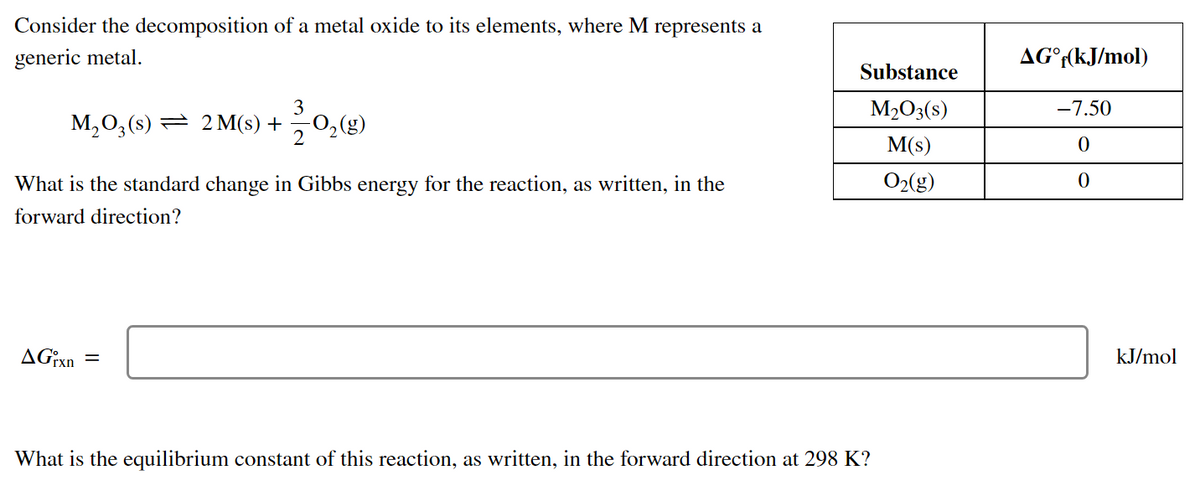Consider the decomposition of a metal oxide to its elements, where M represents a generic metal. AG°r(kJ/mol) Substance 3 M,0,(s) = 2 M(s) + 0,(g) M2O3(s) -7.50 M(s) What is the standard change in Gibbs energy for the reaction, as written, in the O2(g) forward direction? AG¡xn = kJ/mol What is the equilibrium constant of this reaction, as written, in the forward direction at 298 K?
Consider the decomposition of a metal oxide to its elements, where M represents a generic metal. AG°r(kJ/mol) Substance 3 M,0,(s) = 2 M(s) + 0,(g) M2O3(s) -7.50 M(s) What is the standard change in Gibbs energy for the reaction, as written, in the O2(g) forward direction? AG¡xn = kJ/mol What is the equilibrium constant of this reaction, as written, in the forward direction at 298 K?
Chemistry: Principles and Reactions
8th Edition
ISBN:9781305079373
Author:William L. Masterton, Cecile N. Hurley
Publisher:William L. Masterton, Cecile N. Hurley
Chapter16: Spontaneity Of Reaction
Section: Chapter Questions
Problem 62QAP: Consider the reaction NH4+(aq) H+(aq)+NH3(aq) Use G f for NH3(aq) at 25C=26.7 kJ/mol and the...
Related questions
Question

Transcribed Image Text:Consider the decomposition of a metal oxide to its elements, where M represents a
generic metal.
AG°((kJ/mol)
Substance
3
M,0,(s) = 2 M(s) +
-0,(g)
M2O3(s)
-7.50
M(s)
What is the standard change in Gibbs energy for the reaction, as written, in the
O2(g)
forward direction?
AG¡xn
kJ/mol
What is the equilibrium constant of this reaction, as written, in the forward direction at 298 K?
Expert Solution
This question has been solved!
Explore an expertly crafted, step-by-step solution for a thorough understanding of key concepts.
This is a popular solution!
Trending now
This is a popular solution!
Step by step
Solved in 2 steps with 2 images

Knowledge Booster
Learn more about
Need a deep-dive on the concept behind this application? Look no further. Learn more about this topic, chemistry and related others by exploring similar questions and additional content below.Recommended textbooks for you

Chemistry: Principles and Reactions
Chemistry
ISBN:
9781305079373
Author:
William L. Masterton, Cecile N. Hurley
Publisher:
Cengage Learning

Chemistry: Principles and Reactions
Chemistry
ISBN:
9781305079373
Author:
William L. Masterton, Cecile N. Hurley
Publisher:
Cengage Learning